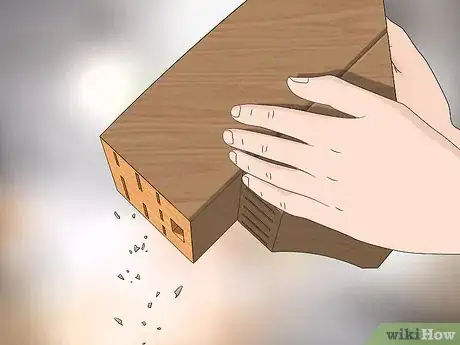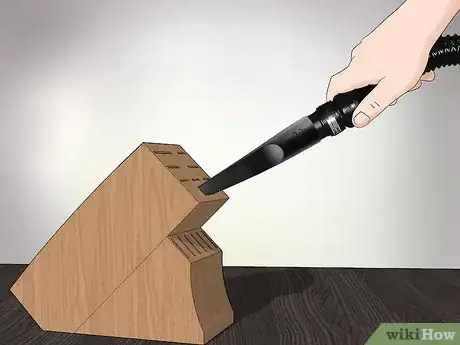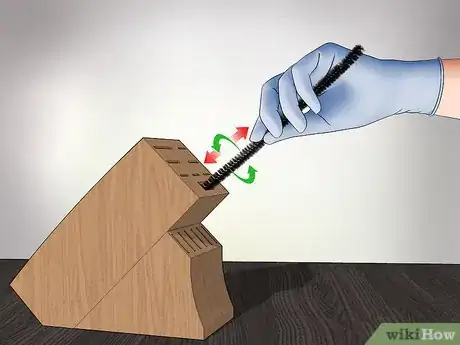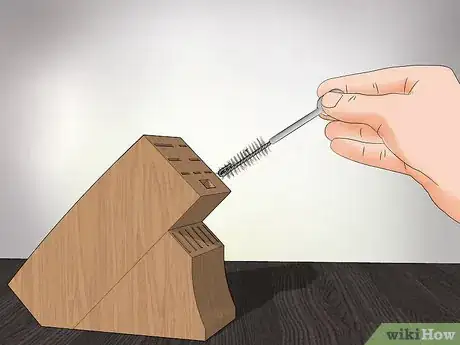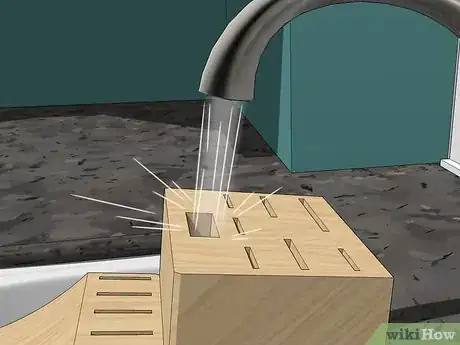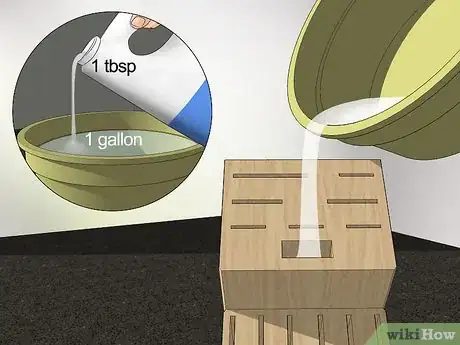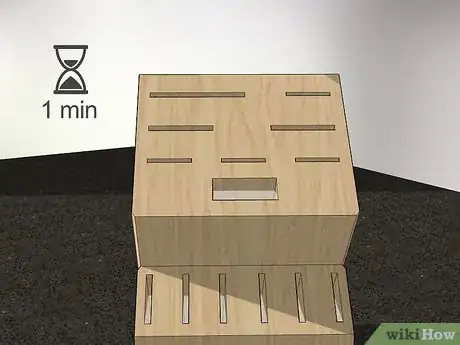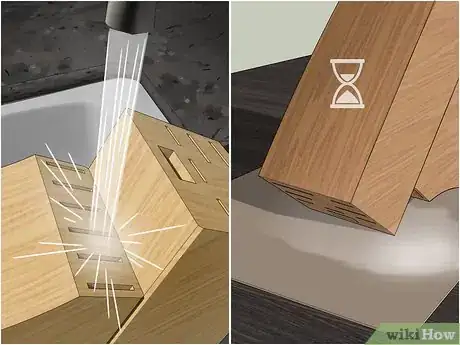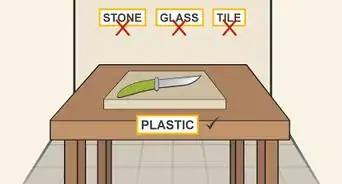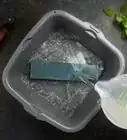X
This article was co-authored by Alessandra Mendes. Alessandra Mendes is a Cleaning Specialist and the Founder of Cleaning Glow. With ten years of experience, Alessandra and her team specialize in providing residential cleaning services in the San Francisco Bay Area. All members of the Cleaning Glow team have completed thorough background checks.
This article has been viewed 34,395 times.
A knife block can foster mold and bacteria, particularly down in the knife slots. Start by removing any crumbs and debris from inside the block. Next, you'll want to thoroughly clean the block inside and out with soap and water. Finish up by sanitizing the block with a mild bleach solution.
Steps
Part 1
Part 1 of 3:
Removing Crumbs
-
1Turn it over. One simple way to start removing some of the crumbs or debris that may have built up in your knife block is to simply turn the whole thing over. Spend a minute or two shaking it over the trash to help remove crumbs.[1]
- To help the process along, try using a blow dryer to dislodge crumbs.[2]
-
2Try the vacuum. Attach the crevice tool to the hose, and use it to get down as far as you can into the knife block. That should suction out most of the debris.[3]Advertisement
-
3Use a pipe cleaner to get down into the slots. Stick it in there, using it to get far into the corners. You may need to twist or swirl it around a bit to capture the grime. Clean your tool off from time to time so you are still removing dirt instead of adding it.
Advertisement
Part 2
Part 2 of 3:
Cleaning the Block
-
1Scrub the outside down. Using hot, soapy water, scrub the outside of the block down. Don't forget to get the underside, too, as that can build up bacteria. You may need to scrub harder to get off any grease or sticky spots.[4]
-
2Wash inside the knife slots. For this part, you'll need a slender brush. A baby bottle nipple brush works, but you can also try a pipe cleaner. Use it to scrub inside the knife slots, getting as far down in there as you can.[5]
-
3Rinse it off. Starting with the inside, flush the block with warm water to rinse off the soap. Move to the outside, making sure to rinse off all sides of the block thoroughly with water. You may need to rub it with your hands a bit to make sure the soap is gone.[6]
Advertisement
Part 3
Part 3 of 3:
Sanitizing the Block
-
1Pour a bleach solution into the knife slots. Mix a tablespoon of bleach with a gallon of water. Pure bleach is too strong for this purpose, and this mixture will efficiently sanitize the block. Wipe the solution around the outside of the container, and then pour the mixture into the slots, filling them up all the way.[7]
- Instead of bleach, you can use undiluted vinegar or hydrogen peroxide.
-
2Let the mixture sit. The block needs to sit with the solution on it for about a minute, which will help sanitize the block. You can leave it for longer, but try not to let it dry on the block.[8]
-
3Rinse and dry. Rinse the block thoroughly. Make sure you get water into the slots, as well as all around the outside to rinse off the bleach. Once you're done, place it upside down on a clean towel, and leave it to air dry. Wait until the slots are dry before putting the knives back in.[9]
Advertisement
References
- ↑ http://www.today.com/home/10-germy-spots-your-kitchen-you-dont-know-about-how-2D79684425
- ↑ http://www.goodhousekeeping.com/home/cleaning/tips/a24647/knife-block-slots-cleaning/
- ↑ http://www.goodhousekeeping.com/home/cleaning/tips/a24647/knife-block-slots-cleaning/
- ↑ http://www.today.com/home/10-germy-spots-your-kitchen-you-dont-know-about-how-2D79684425
- ↑ http://www.nsf.org/consumer-resources/health-and-safety-tips/home-cleaning-tips-germ-hot-spots/clean-kitchen-items
- ↑ http://www.nsf.org/consumer-resources/health-and-safety-tips/home-cleaning-tips-germ-hot-spots/clean-kitchen-items
- ↑ http://www.today.com/home/10-germy-spots-your-kitchen-you-dont-know-about-how-2D79684425
- ↑ http://www.nsf.org/consumer-resources/health-and-safety-tips/home-cleaning-tips-germ-hot-spots/clean-kitchen-items
- ↑ http://www.today.com/home/10-germy-spots-your-kitchen-you-dont-know-about-how-2D79684425
About This Article
Advertisement
